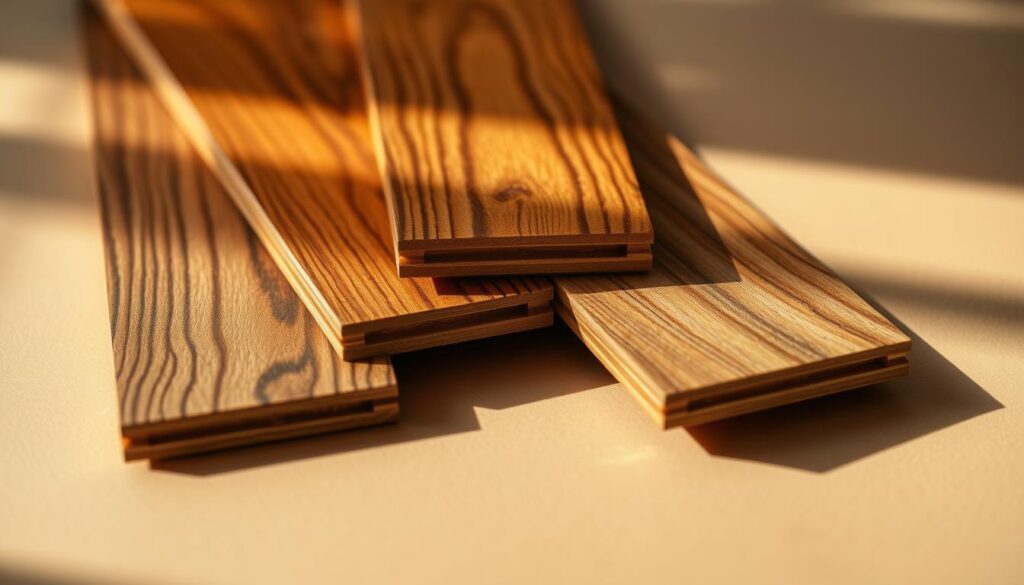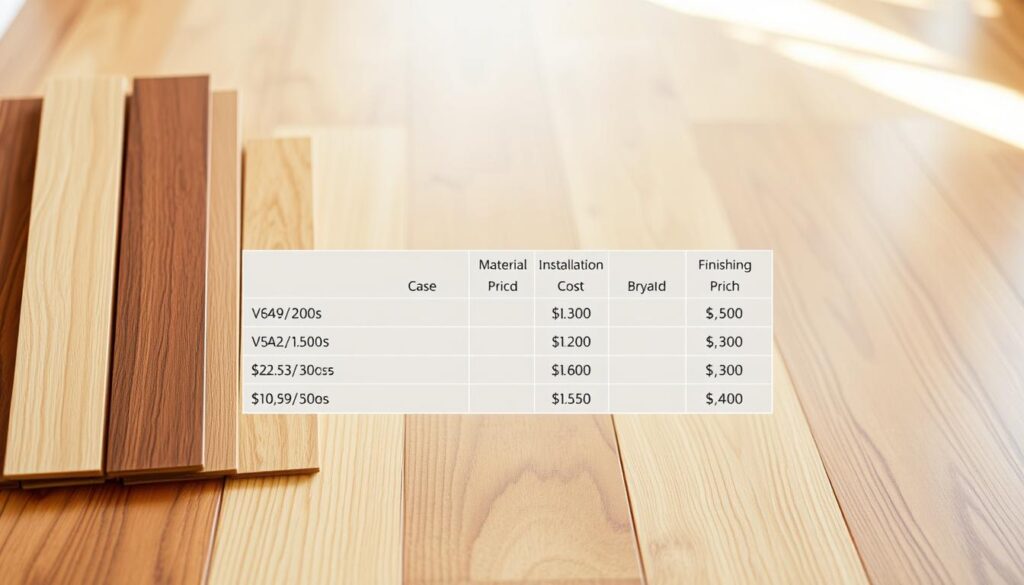Discover the top 1 2 hardwood flooring options for your home. Our expert-curated list will help you find the perfect fit.
Finding the perfect flooring can change your home from ordinary to amazing. The 1/2 inch hardwood flooring is a great choice for those who want durability without too much thickness. It’s popular in American homes for many reasons.

Half-inch wood floors offer a perfect mix. They feel substantial but are easy to install. They work well in old homes or new ones, staying stable through seasons and humidity changes.
Many top brands like Bruce, Armstrong, and Mohawk offer great 1/2 inch options. They have beautiful finishes, many wood types, and advanced tech to make floors look and perform better.
This guide helps you find the best 1/2 inch hardwood floors. We’ll talk about why this thickness is great, compare solid and engineered wood, and show you the best collections out there.
Key Takeaways
- Half-inch wood floors offer an optimal balance of durability and installation flexibility
- This thickness works well in both new construction and renovation projects
- Engineered wood flooring at 1/2 inch thickness provides superior stability in varying humidity
- Top hardwood brands offer extensive style options in this popular thickness
- The 1/2 inch option typically delivers better value than thicker alternatives
- This thickness can be installed in areas where solid hardwood traditionally cannot go
Understanding 1/2 Inch Hardwood Flooring Basics
Choosing the right hardwood flooring thickness is key for your home’s comfort, style, and durability. The 1/2 inch thickness is a great choice for most homes. It offers a good balance of performance.
What Makes 1/2 Inch Thickness Special
The 1/2 inch profile is perfect for many reasons. It’s durable but also easy to install. This thickness is great for homes with changing weather.
Mid-thickness wood floors are ideal for areas where different floors meet. They fit well and also help with sound.
Comparing Engineered vs. Solid 1/2 Inch Options
Engineered and solid hardwood in the 1/2 inch category have their own perks. Solid hardwood is classic and can be refinished many times. Engineered hardwood is stable and works well in humid places.
- Solid hardwood: Better for dry environments, offers multiple refinishing opportunities
- Engineered hardwood: Superior stability in humid areas, wider installation flexibility
- Both types: Available in numerous wood species, finishes, and styles
The Versatility Factor of Mid-Thickness Flooring
1/2 inch flooring is versatile for any room. It looks great in living rooms, bedrooms, and dining areas. You can install it in different ways, depending on your subfloor and preference.
Top 1/2 Hardwood Flooring Brands and Collections
Finding the best premium 1/2 inch hardwood can be tough. Bruce Flooring’s Dundee collection is a top choice. It has precise planks and a 25-year warranty, showing their trust in their product.
https://youtube.com/watch?v=0XRnkwxul40
Shaw Floors is known for making quality wood floor manufacturers. Their Repel technology adds moisture resistance to their 1/2 inch hickory and oak floors. The Reflections collection is both durable and stylish.
The best hardwood flooring brands offer many finish options. Mohawk’s RevWood Plus line has realistic wood looks and is easy to install thanks to GenuEdge technology.
- Armstrong Flooring – Known for their Diamond 10 technology offering superior scratch resistance
- Mirage Hardwood – Features ultra-stable Engineered Lock construction ideal for various installation methods
- Somerset – American-made with eco-friendly manufacturing practices and exceptional color consistency
Bona certified finishes are found in many top-rated flooring products. They ensure low VOC emissions for better air quality. Mannington’s restoration collection brings old wood looks to today’s homes with their 1/2 inch engineered options.
For those on a budget, Mullican Flooring is a great choice. They offer quality floors at good prices, with a 25-year finish warranty.
The Essential Benefits of Choosing Half-Inch Hardwood
Half-inch hardwood flooring is a top choice for homeowners. It offers both quality and practicality. This thickness is gaining popularity in American homes for its unique benefits.
Durability and Longevity Advantages
Half-inch hardwood is known for its durability. Its thick wear layer can handle 2-3 refinishing cycles over many years. This makes it perfect for homes with kids and pets.
The construction is strong, resisting dents and damage. It also holds up well through seasonal changes.
Installation Flexibility and Compatibility
Half-inch hardwood is easy to install in any home. It works well with:
- Various subfloor materials including concrete and plywood
- Radiant heating systems without warping concerns
- Multiple installation methods from nail-down to floating applications
Aesthetic Appeal and Design Versatility
Half-inch hardwood offers a wide range of design choices. You can choose from exotic species like Brazilian cherry to classic oak. Finishes range from hand-scraped to smooth.
This thickness supports wide planks for a dramatic look or narrow boards for a classic feel.
Value Proposition for American Homeowners
From a flooring investment value, half-inch hardwood is a smart choice. It costs more than thinner options but less than solid ones. Yet, it offers great long-term value.
Real estate experts say quality hardwood floors boost property values. They can return 70-80% of the initial investment. This thickness gives a premium look without breaking the bank.
Popular Wood Species Available in 1/2 Inch Thickness
The 1/2 inch thickness format offers a wide range of wood species. Oak hardwood flooring is the top choice for many. It’s known for its unique grain patterns and durability. Red oak has warm tones, while white oak has cooler, more modern colors.
Maple wood floors have a clean look with subtle grain patterns. They’re perfect for modern homes. Their light color brightens rooms and is hard to dent, with a Janka hardness of 1450.
Hickory and walnut are great for those who love dramatic grain patterns. Hickory is very hard, great for busy areas. Walnut floors are rich and luxurious, getting darker with age.
Exotic hardwood species like Brazilian cherry and tigerwood add unique beauty to 1/2 inch floors. They’re harder and have colors you won’t find in domestic woods.
| Wood Species | Janka Hardness | Color Range | Best For |
|---|---|---|---|
| Red Oak | 1290 | Light tan to pinkish red | Traditional homes, versatile spaces |
| Maple | 1450 | Pale cream to light reddish-brown | Modern interiors, bright spaces |
| Hickory | 1820 | Light cream to dark brown | High-traffic areas, rustic designs |
| Brazilian Cherry | 2350 | Rich reddish-brown | Luxury spaces, dramatic interiors |
Choosing wood species depends on your home’s traffic, humidity, and style. Harder woods like hickory or Brazilian cherry are good for busy homes. Quieter spaces can enjoy the beauty of walnut or maple.
Style and Design Considerations for Your Space
The perfect hardwood floor turns a house into a home that’s truly yours. It should match your style and needs, making your space more special.
Color and Finish Options
Hardwood floor colors now range from light blonde to deep ebony. Gray and greige tones are also popular in modern homes. Natural oak is classic, while walnut adds a touch of elegance.
Wood floor finishes also matter. Matte finishes hide marks well, while satin adds a soft glow. Semi-gloss shines bright and is great for formal areas.
Plank Width and Pattern Choices
Wide plank hardwood makes rooms feel bigger and shows off more wood grain. Planks 5-8 inches wide are common in modern homes. Mixing plank widths adds interest.
Choosing a pattern changes how a room looks. Straight planks fit most rooms, while herringbone adds elegance to dining and entryways. Chevron patterns bring energy to open spaces.
Matching Your Home’s Architecture
Your flooring should match your home’s style. Colonial and Victorian homes look good with narrower planks in rich tones. Modern homes do well with wide planks and cool colors.
Farmhouse styles love wide planks with visible grain. Transitional homes do best with neutral finishes and medium-width planks. They adapt to changing styles easily.
Installation Methods and Best Practices
Installing hardwood floors needs careful planning and the right techniques. This ensures your floors look great and last long. Your 1/2 inch hardwood flooring needs a thoughtful installation to last and look its best.

DIY vs. Professional Installation
Some homeowners choose DIY wood flooring to save money. This is good if you know carpentry and have the right tools. DIY costs $2-4 per square foot in materials, compared to $6-12 with a pro.
| Factor | DIY Installation | Professional Installation |
|---|---|---|
| Cost | Lower upfront costs | Higher but includes labor |
| Time | 3-5 days (500 sq. ft.) | 1-2 days (500 sq. ft.) |
| Warranty | May void manufacturer warranty | Typically preserves warranty |
Subfloor Requirements
Getting your subfloor ready is key for beautiful floors. It must be clean, flat, and dry before you start.
- Concrete subfloors need moisture testing with readings below 3%
- Wood subfloors require testing below 12% moisture content
- Floor level should vary no more than 3/16″ over 10 feet
- Remove all debris and vacuum thoroughly
Acclimation and Preparation Steps
Acclimating your flooring prevents warping and gaps. Keep unopened boxes in the room for 3-5 days. Keep the room’s temperature between 65-75°F and humidity at 35-55%. Only open boxes when you’re ready to install. Lay boards perpendicular to floor joists for stability.
Maintenance and Care Tips for Long-Lasting Beauty
Proper care of your hardwood floors can make them last longer and look better. Start by sweeping with a soft-bristle broom to remove small particles. For a deeper clean, use a microfiber mop with a bit of water and a cleaner approved by the manufacturer.
Be careful not to use too much water when cleaning. Too much moisture can harm even the toughest finishes. Water can also cause warping and damage the structure of thinner floors.
To protect your floors, use felt pads under furniture legs and area rugs in busy areas. Keep the humidity in your home between 35-55%. Also, remove shoes at the door to prevent dirt and grit from scratching the wood.
Refinish your floors every 7-10 years, depending on how much they wear. The 1/2 inch thickness is enough for 2-3 refinishing cycles. This way, you can keep your floors looking new without having to replace them completely.
- Clean spills right away with a dry or slightly damp cloth
- Use furniture coasters to prevent dents
- Apply window treatments to protect from UV rays that fade wood
- Get a professional to deep clean your floors once a year
| Finish Type | Recommended Cleaning Method | Products to Avoid |
|---|---|---|
| Polyurethane | pH-neutral wood cleaner | Wax, oil soap, vinegar |
| Oil-based | Specialized oil refreshers | Ammonia, alcohol cleaners |
| Wax finish | Solvent-based cleaners | Water-based products |
Cost Analysis and Budget Planning
When planning your budget for new 1/2 inch hardwood floors, it’s important to consider both upfront costs and long-term benefits. The cost of hardwood flooring varies a lot. This depends on the quality, type, and finish you choose.

Price Ranges Across Different Brands
Wood floor prices fall into three main categories:
- Economy options: $3-$6 per square foot
- Mid-range selections: $6-$10 per square foot
- Premium brands: $10-$15+ per square foot
These prices are just for the materials. To plan your budget fully, remember to add $2-$5 per square foot for underlayment, adhesives, trim, and other installation needs.
Value Considerations Beyond Initial Cost
When choosing wood floors, don’t just look at the price. Important factors include warranty length, quality standards, and customer support. Brands with 25+ year warranties might cost more upfront but offer longer protection.
Factory finishes are often more durable and consistent than site-finished options. This makes them a good choice for many homeowners who are careful with their budget.
Long-Term Investment Perspective
Investing in quality hardwood is a smart move. Unlike carpet or vinyl, which need to be replaced every 5-10 years, hardwood floors can last 25+ years. This can save you money over time.
Studies show homes with hardwood floors sell faster and for 3-5% more than homes with other flooring. When you calculate the cost of wood floors, remember to include this potential increase in value and the savings from not needing to replace them as often.
Conclusion: Making the Right 1/2 Inch Hardwood Flooring Choice
Exploring the best hardwood flooring options leads you to 1/2 inch hardwood. This guide has given you a deep look into its benefits and styles. Now, you know what to consider when choosing.
Looking for quality wood flooring that lasts? Or maybe you want the design freedom of 1/2 inch thickness? This guide helps you weigh what’s important for your home. You can pick the 1/2 inch hardwood that will make your space beautiful and durable.
The right choice is the one that fits your needs and taste. Use this guide to help you find the perfect hardwood floors for your home.
FAQ
What makes 1/2 inch hardwood flooring a special thickness?
The 1/2 inch thickness is a good middle ground. It’s durable but also easy to install. This size is stable and works well with many floors and types of subfloors.
How do engineered and solid 1/2 inch hardwood options differ?
Engineered 1/2 inch hardwood has layers with a real wood top. It’s stable. Solid 1/2 inch hardwood is one piece of wood. It looks traditional and can be refinished.
What are the key benefits of choosing 1/2 inch hardwood flooring?
It’s durable and lasts long. It’s easy to install and looks great. It’s also a good value for American homeowners.
What are the most popular wood species available in 1/2 inch thickness?
Oak, maple, hickory, and walnut are common. They have different looks and hardness. Exotic woods add unique beauty.
How do I choose the right color, finish, and plank width for my space?
Think about current trends and the look you want. Choose a finish and plank size that fits your style. Make sure it matches your room’s design.
What are the key installation requirements for 1/2 inch hardwood flooring?
You need to prepare the subfloor and test for moisture. Make sure the floor is acclimated. Decide if you’ll install it yourself or hire a pro.
How do I properly maintain 1/2 inch hardwood flooring for long-lasting beauty?
Clean it regularly with the right products. Use furniture pads and do seasonal maintenance. You might need to refinish it to keep it looking good.
What are the typical cost ranges for 1/2 inch hardwood flooring?
Prices vary by brand and quality. You’ll also need to consider underlayment and trim costs. Think about the long-term value when deciding.
Read also : 1 16 Wood Crafts: 16 Unique and Practical DIY Ideas
